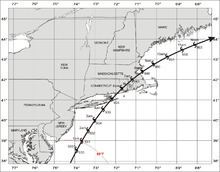Formed August 1635 (1635-08) Start date 1635 | Highest winds 209 km/h Fatalities 46 | |
 | ||
Dissipated August 25, 1635 (1635-08-26) Lowest pressure ≤ 930 mbar (hPa); 27.46 inHg(Estimated ) Date August 1635 – 25 August 1635 Similar 1815 New England hurricane, 1944 Great Atlantic hurricane, 1856 Last Island hurricane, 1938 New England hurricane, Hurricane Carol | ||
The Great Colonial Hurricane of 1635 was a severe hurricane which brushed Virginia and then passed over southeastern New England in August of that year. Accounts of the storm are very limited, but it was likely the most intense hurricane to hit New England since European colonization.
Contents
Meteorological history
The first recorded mention of the Great Colonial Hurricane was on August 24, 1635 at the Virginia Colony at Jamestown. It affected Jamestown as a major hurricane, although no references can be found to damage, probably because the hurricane evidently moved past rapidly, well east of the settlement.
Governors John Winthrop of Massachusetts Bay Colony and William Bradford of Plymouth Colony recorded accounts of the Great Colonial Hurricane. Both describe high winds, 14 to 20 foot storm surges along the south-facing coasts of Massachusetts and Rhode Island, and great destruction.
Impact
Much of the area between Providence, Rhode Island and the Piscataqua River was damaged by the storm, and some damage was still noticeable 50 years later. Governor Bradford wrote that the storm drowned seventeen Indians and toppled or destroyed thousands of trees; many houses were also flattened.
The small barque Watch and Wait owned by a Mr. Isaac Allerton foundered in the storm off Cape Ann with 23 people aboard. The only survivors were Antony Thacher and his wife, who reached Thacher Island. Thacher later wrote an account of the shipwreck.
In Narragansett Bay, the tide was 14 feet (4.3 m) above the ordinary tide and drowned eight Indians fleeing from their wigwams. The highest such recorded value for a New England Hurricane was a 22-foot (6.7 m) storm tide recorded in some areas. The town of Plymouth suffered severe damage with houses blown down. The wind cut great mile-long sections of complete blowdown in the woods near Plymouth and elsewhere in eastern Massachusetts.
It also destroyed Plymouth Colony's Aptucxet Trading Post (on the site of present-day Bourne, Massachusetts).
The Boston area did not suffer from the tide as did areas just to its south. The nearest surge swept over the low-lying tracts of Dorchester, ruining the farms and landscape (from the accounts of Bradford and Winthrop).
Modern analysis
The Hurricane Research Division of the Atlantic Oceanographic and Meteorological Laboratory of NOAA has conducted a re-analysis project to re-examine the National Hurricane Center's data about historic hurricanes. In association with the project, Brian Jarvinen, formerly of NHC, used modern hurricane and storm surge computer models to recreate a storm consistent with contemporaneous accounts of the colonial hurricane.
Jarvinen estimated that the storm was probably a Cape Verde-type hurricane considering its intensity, which took a track similar to the Great Atlantic Hurricane of 1944 and Hurricane Edna of 1954. The storm's eye would have struck Long Island before moving between Boston and Plymouth. It would likely have been a Category 4 or 5 hurricane farther south in the Atlantic, and it was at least a strong Category 3 hurricane at landfall with 125 mph (201 km/h) sustained winds and a central pressure of 938 mbar (27.7 inHg) at the Long Island landfall and 939 mbar (27.7 inHg) at the mainland landfall. This would be the most intense known hurricane landfall north of the Carolinas and Mid-Atlantic states. Jarvinen noted that the colonial hurricane may have caused the highest storm surge along the east coast of the U.S. in recorded history: 20 feet (6.1 m) near the head of Narragansett Bay. He concluded that "this was probably the most intense hurricane in New England history."
An erosional scarp in the western Gulf of Maine may be a trace of the Great Colonial Hurricane.
